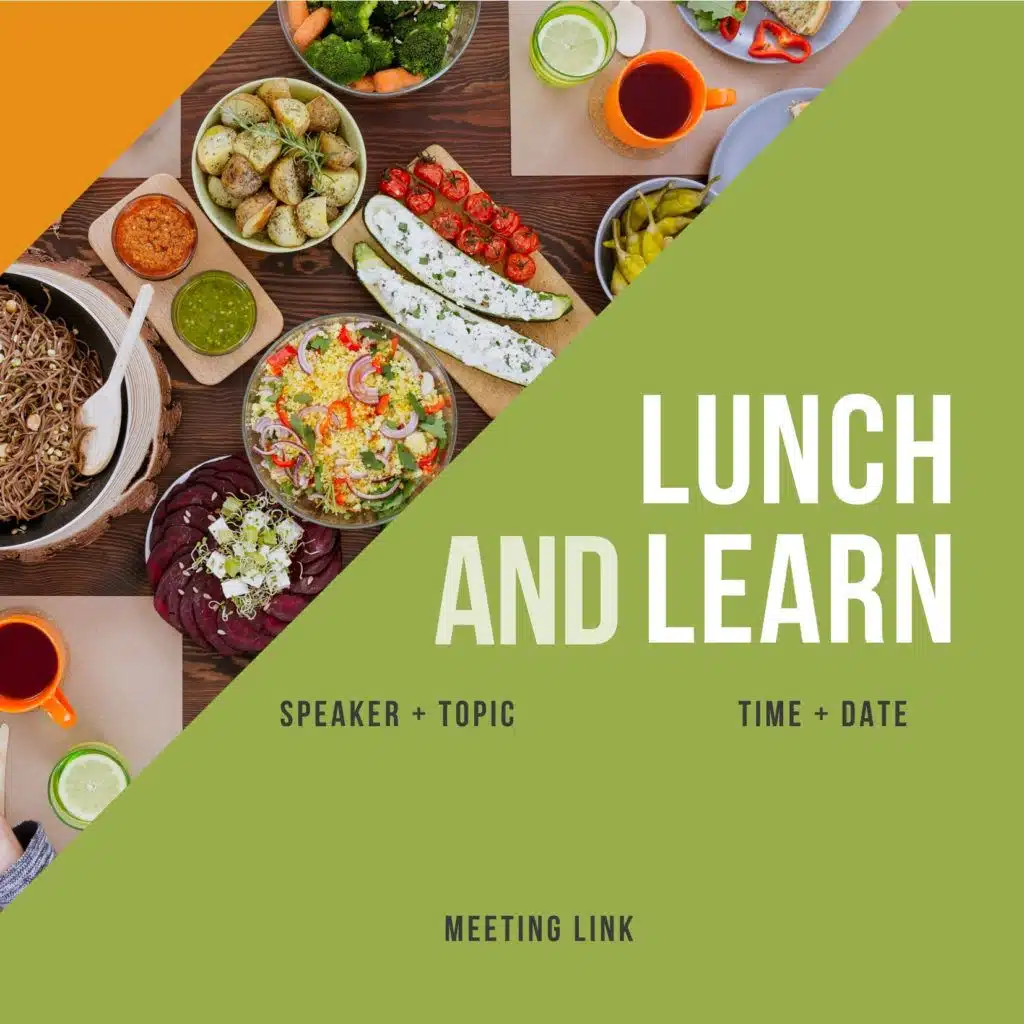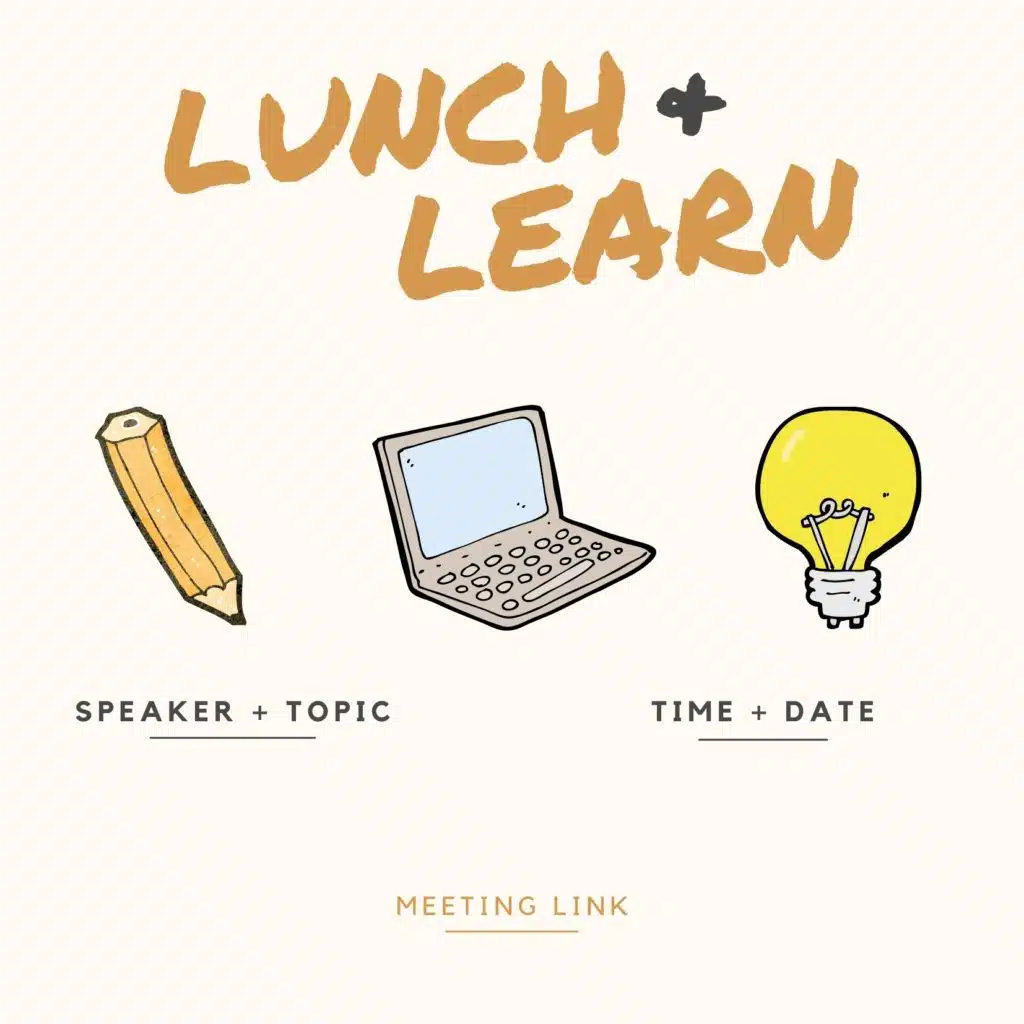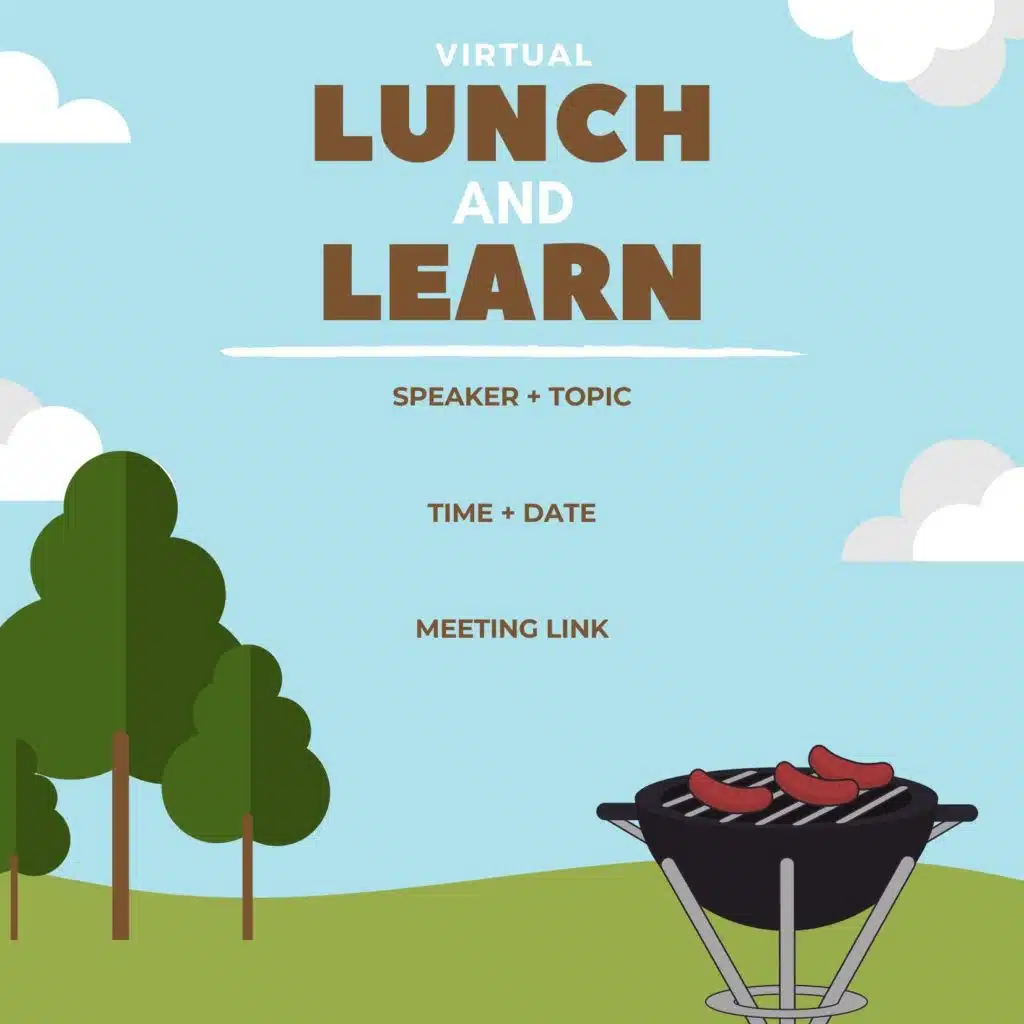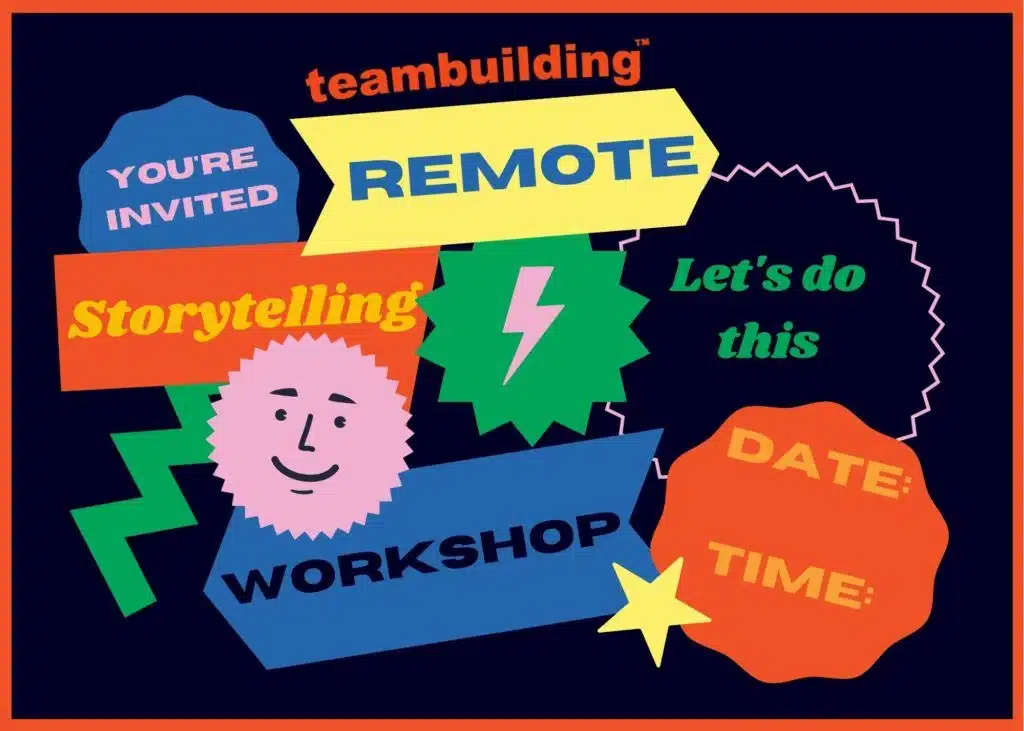You found our list of the best virtual lunch and learn ideas.
Virtual lunch and learns are online sessions where employees log in to hear from a speaker and learn more about a chosen topic. These events usually include a question and answer component, and may also involve group activities. The purpose behind these seminars is to inform employees and encourage growth and continual development.
These events are an example of online employee engagement ideas, corporate workshops, and virtual lunch activities, and are a way to improve company culture.
This article also includes:
- virtual lunch and learn topics
- how to host a virtual lunch and learn
- online lunch and learn tips
- lunch and learn ideas during covid
Here we go!
List of virtual lunch and learn ideas
From online book clubs to Ask Me Anything sessions, here is a list of virtual lunch and learn activities to entertain and enlighten your remote employees.
1. Virtual Lunch and Learn Invitations
A standard email can easily get lost in your coworkers’ inboxes. Busy professionals tend to skim emails, especially longer messages. Designing eye catching virtual lunch and learn invitations is a way to attract more attention to your event.
Even if you possess few graphic design skills, you can quickly create digital flyers and e-cards in Canva. At minimum, you should include the date and time of the event, the speaker, the topic, the meeting link, and any special instructions.
Here are a few examples:



Pro tip: Instead of sending out mass emails, send messages individually and put a name and personal note like “hey I know you were interested in XYZ topic so wanted to pass this along.”
Check out our tutorial on making attractive digital invitations for holiday parties.
2. Nerd Talks

Nerd Talks are TED-style presentations on Zoom. These lectures include interactive elements like icebreakers and remote Bingo to keep audience members engaged and participating. A subject expert leads the one hour event, answering questions and keeping energy high. The talks are available on fun and irreverent topics like Zombies and Philosophy, Beer and Sharks, and Cereal and Serial Killers. Hosts link subjects in unexpected ways, share extraordinary facts, reveal lesser-known history, and shift perspectives.
Get our free team building toolbox
- icebreaker games
- bingo cards
- DIY guides
 by teams at FedEx, Amazon, Deloitte and 73,930+ others
by teams at FedEx, Amazon, Deloitte and 73,930+ others

3. Storytelling Workshops

Storytelling Workshops are ideal professional development for longer remote lunch and learns. During this two hour event, a facilitator guides groups through a writing masterclass, sharing tips on how to make stories engaging and impactful. Participants learn composition hacks and presentation hints, gaining a deeper understanding of coworkers in the process. At the end of the event, participants compose and share original stories, and teammates provide praise and constructive criticism. Storytelling Workshops’ narrative lessons have practical applications in the workplace. The skills gained through this event can empower marketers, salespeople, HR professionals, and managers to be more persuasive, confident, and empathetic.
Learn more about Storytelling Workshops.
4. Comedy Workshops

Lunch and learns do not have to be directly related to work. Many sessions focus on life skills or hobbies. Comedy Workshops is a crash course in standup, led by a seasoned comedian. This 90 minute virtual event breaks down the art of humor by dissecting some of the funniest jokes in history, and passing along time-tested techniques. At the end of the class, attendees craft and share one-liners and practice joke delivery. Comedy Workshops are a way to inspire camaraderie among remote teams while improving soft skills. Plus, you might just learn that unassuming Olga in accounting is hilarious.
Note — This event is bookable by special request, and is not available in December. Plan a call with our Client Advisors to learn more.
5. Ask Me Anything
Ask Me Anything is an online question-and-answer session format popularized by Reddit. Typically, an expert spends an hour answering questions in a forum. You can publicly host the session on a social media site like Twitter or Instagram, or hold a company-only event using mediums such as Slack channels, Google Meet Q&A, or internal forums.
This approach is more collaborative than a standard submit-your-questions setup, as participants can get inspired by and piggyback off of each others’ questions. Also, since queries are out in the open at one time, askers are not at the mercy of the facilitator calling on raised hands. Experts can even prioritize the most popular questions based on how many other participants like or react to a posted inquiry.
Here is a helpful Social Media Examiner guide to running Ask Me Anything sessions.
6. Virtual Keynote Speaker
Inviting a virtual keynote speaker to speak at your company can be a great way to facilitate a lunch and learn. These speakers tend to have experience working with groups in a way that provides inspiration and motivation for change. The investment for your keynote will be more then your typical lunch and learn, but so will the payoff.
Check out this list of the best virtual keynote speakers.
7. Peer to Peer Lessons
In addition to looking outside of your organization for speakers, you can also showcase your employees. Your colleagues have knowledge about a variety of work and non-work subjects. Peer to peer lessons give teammates a platform to share that expertise.
First, ask your team for volunteers. If you plan to run these lessons as a series, then you can repeat this request periodically.
Next, come up with a simple proposal process. Speakers should present their subject and general plan for approval. After okaying the topic, work with the presenter to set a date and time. You should also plan a short technical run-through to help the real event run more smoothly. Finally, invite other staff and hold your sessions.
This activity is a win-win. Teammates find out more about remote coworkers’ multifaceted personalities and skill sets while learning about a relevant topic. These sessions also fine tune the presenters’ public speaking abilities and instill confidence.
8. Online Book Club
Book Clubs are ideal virtual lunch and learn activities. The talk-based exercise is educational and translates easily to Zoom. To hold a virtual book club session, first choose and announce a book a month or so in advance. You can boost participation by sending guests a physical or digital copy of the chosen title or to reimbursing the purchase.
Next, research or write discussion questions. Finally, meet up on Zoom and discuss the book together.
Participants can read books intended for pleasure or career development. Check out these books on professional topics for reading recommendations.
9. Online Lunch and Learn Library
Interested employees may not be able to attend a live lunch and learn. Employees may get busy or forget, or may join the company long after the lecture. Luckily, recording virtual meetings is easy, meaning you can build a library of past sessions for staff to watch or rewatch anytime.
Before hitting the record button, be sure to get presenter and participant consent. Remind attendees of the option to turn off webcams and rename themselves for extra privacy. The meeting recording will save to the cloud or a specified folder. After the event, you can edit the video and then upload the file to a shared Google Drive Folder. All team members should be able to access the folder at any time. Notifying new hires of the library during virtual onboarding is also helpful.
Pro tip: Type up a quick guide to each file so that viewers can skip around and watch the most relevant points. Include timestamps for easy navigation. For instance, “Q&A starts at 45:66.”
List of example virtual lunch and learn topics
Here are some sample suggestions for virtual lunch and learn subjects.
Professional online lunch and learn topics
- Allyship in the office
- Public speaking
- Social media tools and tactics
- Benefits basics
- Vendor spotlight
- Software demonstrations
- Time management skills
- Balancing parenting with work
- Networking skills
- Coding fundamentals
- Conflict resolution
- Leadership without a title
- Professional writing
- Negotiation workshop
- Ecommerce essentials
Work from home lunch and learn topics
- Work from home productivity hacks
- How to manage remotely
- Healthy work from home snack and meal prep
- Home office feng shui
- Finding your optimal workflow
- Security and compliance when working remotely in public
- Socializing in virtual offices
- Building boundaries when working remotely
- Hybrid office how-to’s
- Deskercise
- How to shop for home office furniture
- Digital nomad life
Life skills Zoom lunch and learn topics
- Bitcoin basics
- Homebuying 101
- Stress management
- Financial advising
- Retirement planning
- Bullet journaling workshop
- Mindfulness
- Plant parenting
- Home organizing
- Ways to volunteer from home
- Basic home repairs
- Evaluating information sources
- Self-compassion best practices
- Composting and zero waste
- Real estate essentials
Just-for-fun remote lunch and learn topics
- Tarot how-to
- Tea of coffee tasting
- Wine or beer tasting
- Local business owner spotlight
- Travel blogging and photography
- Writing workshop
- Historical tour
- Ghost tour
- Herb growing and urban farming
- Sustainable scavenging
- Improv comedy
- Pet treat baking
- Drone photography
- Calligraphy and lettering
You can also tailor topics to your industry and organization. Another good idea is to align talks with your company’s core mission and values.
How to host a virtual lunch and learn
Here are the steps to hosting an interesting and engaging remote lunch and learn.
1. Select the right software
It is important to choose the platform most suitable for the format of your talk. For instance, if the schedule includes small group discussion and team activities, then Zoom’s breakout rooms arw best. For non-disruptive questioning, Google Meet’s Q&A feature comes in handy. Questions will not go overlooked in the chat, and other participants can vote for interesting inquiries. If planning a large scale webinar, then consider GoToWebinar, which can accommodate 3,000 guests.
Start by assessing whether your company’s current software fits your session’s needs. You can also talk with the IT department to figure out available meeting platform options.
For more information, check out this guide to video meeting platforms.
2. Choose a topic and speaker
You may have a specific speaker in mind, or you may only know what topic you want to address. There is no one correct formula for choosing a virtual lunch and learn subject or host. The program may also depend on host availability, so be sure to have a few option.
Events such as Black History Month, Women’s History Month, or Asian Pacific Islander Heritage Month can add structure to your schedule. However, keep in mind that experts will be in high demand during these times, and plan to book early.
You can also ask your staff for recommendations.
3. Make the meeting link and send out invitations
When you have chosen the platform, booked the speaker, and settled the date and time, the next step is sending out invitations. For privacy’s sake, never post a meeting link publicly. Instead, send the link via email or post to a private channel.
It is a good idea to send out both an email invitation and a calendar invite, so that the staff can access the information in multiple spots and will receive an automatic reminder before the event.
4. Gather online and facilitate the event
To ensure that tech is working properly, hosts and co hosts should plan to join the meeting ten or fifteen minutes early. As the starting time approaches, begin to let attendees in from the waiting room. For best results, leave a couple of minutes of buffer time for folks to filter in and get settled.
When the presentation begins, spotlight the speaker. Including visual elements is a good way to keep the crowd engaged, especially screen sharing slideshows. Be sure to keep an eye on the chat for questions, and encourage employees to engage with each other and react as well. Acknowledging comments in the chat, even non-questions, makes the event feel more interactive and intimate.
Virtual events can flow quickly, so be sure to keep an eye on the clock and stick to the schedule. Answering questions throughout the session will keep the audience more engaged, however you may need to defer some questions until the end of the meeting to ensure a smooth flow and cover all material. If questions remain and the host is willing, you could either extend the Zoom meeting or allow attendees to email questions post-event.
5. Send a recap and follow-up email post-event
Post-event, send participants an email thanking them for attending. You can provide additional materials such as highlights of the talk, the speaker’s social media handles and website, links to related resources, and the meeting recording.
Follow-up emails are also a good way to promote upcoming events. After a positive experience, participants are likelier to RSVP to future virtual lunch-and-learns.
You can also use event management software to run virtual lunch and learns.
Online lunch and learn tips
Here is a list of tips and best practices to help you host more impactful online lunch and learns.
1. Get suggestions from staff
You are unlikely to have good turnouts at these events if you do not choose topics and speakers that appeal to staff. The best way to figure out what interests your employees is to ask the staff directly. Simply send an email or survey to teammates, or post a thread in Slack, and ask for suggestions. One of your colleagues may even be able to put you in contact with a speaker.
2. Pick a time that works best for employees
In virtual offices, teammates work across multiple time zones and often have flexible working hours. While it is difficult to accommodate all schedules, you want to choose a time for your lunch and learn that works for a majority of the staff. The sweet spot tends to be late afternoon for the east coast, and early afternoon or late morning for the west coast, or evening for folks in Europe. Lunch and learns do not need to take place literally at lunch time. You should choose a timeslot where the bulk of your staff is available and alert.
3. Ask attendees to RSVP
Participants are much likelier to attend lunch and learns after RSVP-ing. Plus, organizers can send reminders so that guests do not forget. Not to mention, an RSVP system can help organizers predict turnout, and cancel the event if there is not enough interest.
Sign ups do not have to be strict. Organizers can allow RSVP’s until a few hours before the event and can post the meeting link to a company calendar and Slack channel. However, asking staff to commit to showing up can boost attendance and participation.
4. Vary topics and areas of interest
If you plan to run a series of virtual lunch and learns, then vary the topics to appeal to wider audiences. While some crowds may be larger than others, you will reach and serve a greater number of employees. Having a modest showing for a lunch and learn is not necessarily a bad thing. Smaller groups can mean more intimate discussions and an audience more invested in the topic.
While you may not want to choose an area too niche, choosing different topics will appeal to different teammates. Plus, variety is likely to encourage regular participants to keep coming back.
5. Make presentations interactive
One of the main draws of a lunch and learn is human interaction. Participants who wanted to hear a one-sided lecture could watch a video instead. Virtual lunch and learns give attendees access to experts and interested peers, and organizers should capitalize on social elements. For example, thread question and answer sessions throughout the presentation instead of only at the end, or use breakout sessions for audience interaction and small group discussions. Even reading comments in the chat out loud can help participants feel more like active contributors instead of silent watchers.
Conclusion
Professional development is an important element of employee engagement. Team members who have plentiful opportunities to learn and grow are likely to remain at companies for longer periods of time. Hosting lunch and learning sessions is a way to educate and immerse an online workforce. Not to mention, these gatherings give remote employees a chance for human contact and face to face contact with peers. Plus, these events are a way to shape company culture. The topics chosen for lunch and learns can speak to the company’s core values, and emphasize certain priorities for employees to adopt. If nothing else, then these lectures encourage a culture of continuous learning within the organization.
Next, brush up on virtual meeting etiquette and check out this list of virtual team dinner ideas.




